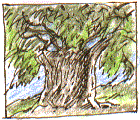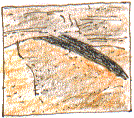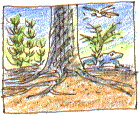Nature Diary Rocks History Gallery Links Home Page Dragonfly A MALE COMMON DARTER hawks over our garden pond in the warm midday sun. Between flights it, or rather he, rests on pebbles or plants at the water's edge. Even while resting, he keeps his large eyes on what is going on, tilting his head. He glides in to use my head as a vantage point, but I brush him away.
A MALE COMMON DARTER hawks over our garden pond in the warm midday sun. Between flights it, or rather he, rests on pebbles or plants at the water's edge. Even while resting, he keeps his large eyes on what is going on, tilting his head. He glides in to use my head as a vantage point, but I brush him away.
Coal ForestsA herd of deer, probably Fallow, were once kept in Bretton Park (between Wakefield and Barnsley). A deer shelter was built, hidden away in a hollow in the crest of a ridge to preserve the open vista across the parkland.
Pollarded Ash The oldest tree in Bretton is probably the Pollarded Ash that stands on the slope by the shelter. Pollarding produced a trunk with a crop of new growth above the level that deer could browse. Was it once cut to provide the deer with green leaves? Or was it pollared to produce a crop of poles for fencing? Ash trees are not all that long lived but cutting back the branches re-invigorates the tree. The heart has rotted out and now the living part of the tree forms one half of a cylinder, the convex side facing the prevailing westerly wind. At the end of the season's growth the foliage is still looking healthy.
The oldest tree in Bretton is probably the Pollarded Ash that stands on the slope by the shelter. Pollarding produced a trunk with a crop of new growth above the level that deer could browse. Was it once cut to provide the deer with green leaves? Or was it pollared to produce a crop of poles for fencing? Ash trees are not all that long lived but cutting back the branches re-invigorates the tree. The heart has rotted out and now the living part of the tree forms one half of a cylinder, the convex side facing the prevailing westerly wind. At the end of the season's growth the foliage is still looking healthy.The ash may have started as a sapling almost half a millenium ago.
|
 In the back wall of the stable, behind a manger, an outcrop of sandstone is exposed. Perhaps the site was originally a small quarry for roadstone or for rough walling. It would make a poor building stone as the bed is broken up by irregular cracks.
In the back wall of the stable, behind a manger, an outcrop of sandstone is exposed. Perhaps the site was originally a small quarry for roadstone or for rough walling. It would make a poor building stone as the bed is broken up by irregular cracks. In the late Carboniferous period, 300 million years ago, this was a sandbank on which the giant trees of the time grew. A large root, now turned to coal, penetrates what was then sandy subsoil. The tree itself probably became part of a coal seam, which has since been removed. Above the bedrock there is a rough stone wall.
In the late Carboniferous period, 300 million years ago, this was a sandbank on which the giant trees of the time grew. A large root, now turned to coal, penetrates what was then sandy subsoil. The tree itself probably became part of a coal seam, which has since been removed. Above the bedrock there is a rough stone wall.